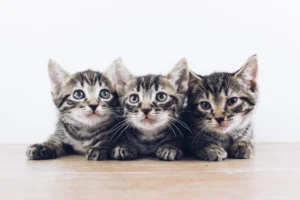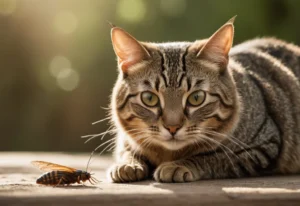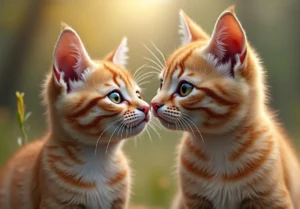Cats are known for their playful nature and hunting instincts, often seen pouncing on flies with lightning speed and precision. But why do cats attack flies? Let’s explore this behavior and uncover the reasons behind it.
When it comes to why cats attack flies, the answer is simple: it’s instinctual. Cats are natural-born hunters, and flies provide the perfect opportunity for them to satisfy their predatory instincts. The buzzing sound and erratic movements of flies trigger the hunting drive in cats, prompting them to stalk and catch the small insects.
Curiosity and Playfulness
Cats are naturally curious creatures with an insatiable desire to explore their surroundings. This innate curiosity often drives them to chase after anything that moves, including flies. Their keen sense of sight and sound alert them to the presence of these tiny insects, triggering their playful instincts to pounce and swat at them.
Furthermore, cats are known for their playful nature, which can be seen in how they engage with toys or even household objects. The erratic flight pattern of a fly mimics the movements of prey, sparking a cat’s hunting instincts and providing them with a fun and stimulating challenge.
So, the next time you see your feline friend going after a fly, remember that it’s not just about catching a bug – it’s about satisfying their natural curiosity and indulging in a game of chase.
Instinctual Behavior
The behavior of cats attacking flies is deeply rooted in their instinctual drive as hunters. Cats are natural-born predators, with a long history of hunting for survival. Even though our domesticated felines may not need to hunt for their food anymore, their hunting instincts remain strong.
When a cat spots a fly buzzing around, it triggers their predatory instincts, causing them to stalk, chase, and catch the elusive insect. This behavior not only satisfies their natural hunting urge but also provides them with mental stimulation and a sense of accomplishment.
It’s important to recognize that when your cat goes after a fly, it’s not just about capturing a small insect. It’s a manifestation of their primal instincts and a way for them to engage in a behavior that is deeply ingrained in their DNA.
Remember, providing your cat with plenty of toys and interactive play sessions can help channel their hunting instincts in a healthy and enriching way.
Hunting Practice
Have you ever noticed your furry feline friend pouncing on pesky flies around the house? Well, it turns out that these playful antics serve a more practical purpose than just getting rid of annoying bugs. When cats attack flies, they are actually honing their hunting skills. This instinctual behavior helps them sharpen their coordination, agility, and predatory instincts, just like they would in the wild. So, the next time you see your cat chasing after a fly, remember that they’re not just having fun – they’re also practicing their hunting techniques to stay sharp and prepared.
Entertainment and Stimulation
Feeling bored and restless is something that no one enjoys, including our beloved cats. Chasing flies not only provides a source of entertainment for our curious feline friends but also keeps them mentally stimulated. It offers a way for cats to engage their natural instincts in a safe and playful manner, preventing them from becoming inactive or lethargic. So, the next time you see your cat swatting at a fly with laser-like focus, rest assured that they are simply enjoying themselves and keeping their minds active at the same time.
Extra Tip:
To encourage your cat’s natural behaviors and provide mental stimulation, consider incorporating interactive toys or puzzle feeders into their daily routine. This will keep them engaged and entertained, even when there are no flies around to chase.
Prey Drive
Cats are natural hunters, and their prey drive is a powerful instinct that motivates them to hunt and catch prey, including flies. This innate behavior dates back to their wild ancestors who relied on hunting for survival. When a cat sees a fly buzzing around, their primal instincts kick in, triggering their internal hunting mode. It’s like a built-in drive that compels them to chase and catch anything that moves like potential prey. So, when your feline friend pounces on a fly, it’s simply their way of fulfilling their natural hunting instincts.
Biological Response
When cats encounter flies, their biological response is fascinating. Their senses become heightened as they lock onto the fluttering movements of the fly, and adrenaline surges through their bodies, preparing them for the hunt. Cats have incredible reflexes and sharp eyesight, allowing them to track and capture fast-moving prey like flies with precision. This biological response is a combination of genetics and instinctual behavior that drives their hunting behavior. It’s like watching a skilled predator in action, showcasing their prowess in the art of hunting.
Additional Unique Insight:
- Cats’ whiskers play a crucial role in their hunting behavior when attacking flies. Whiskers are sensitive touch receptors that help cats navigate and gauge the distance between themselves and their prey, ensuring precise strikes during the hunt. So, when a cat is zeroing in on a fly, their whiskers are working overtime to assist in the capture process.
Environmental Enrichment
When it comes to cats and flies, the buzzing insects can actually provide some fantastic environmental enrichment for our feline friends. The presence of flies in the environment can offer cats mental and physical stimulation, engaging their natural instincts to hunt and play. Cats are natural predators, and chasing after flies can provide them with an outlet for their hunting instincts. It also helps keep them physically active, especially if they spend most of their time indoors.
Cats love the thrill of the hunt, and flies buzzing around can be like a real-life video game for them. It challenges their coordination, agility, and speed, giving them a fun and engaging activity to keep them entertained. So next time you see your cat swatting at a fly, remember that it’s not just a nuisance—it’s actually providing them with valuable mental and physical stimulation.
Interesting Facts About Cats and Flies
Cats and flies have a unique relationship that goes way back. Did you know that cats have a natural instinct to hunt flies because they resemble some of their prey in the wild? Flies are fast-moving and erratic, just like small rodents or birds, making them the perfect target for a cat’s hunting skills.
Another interesting fact is that some cats have a specialized hunting technique for catching flies. They will patiently wait for the fly to land before pouncing on it, using their lightning-fast reflexes to catch their prey in mid-air. It’s a fascinating display of feline prowess and agility.
A fun way to engage your cat’s natural instincts is by using interactive toys that mimic the movement of flies. These toys can provide hours of entertainment for your feline friend and keep them mentally and physically stimulated. It’s a great way to simulate the thrill of the hunt in a safe and controlled environment.
Remember, when it comes to cats and flies, it’s not just about catching the insect—it’s about engaging your cat’s natural hunting instincts and providing them with a fun and enriching activity. So next time you see your cat swatting at a fly, appreciate the incredible bond between these two fascinating creatures.
Alex, a passionate animal lover, has experience in training and understanding animal behavior. As a proud pet parent to two dogs and three cats, he founded AnimalReport.net to share insights from animal experts and expand his knowledge of the animal kingdom.




